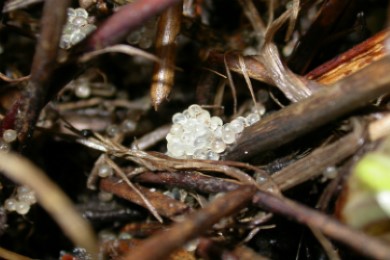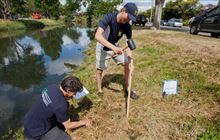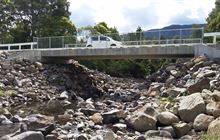Find, protect and create inanga spawning habitat
Introduction
How to find and protect the places where inanga are spawning already, and make new places that are suitable for spawning.Inanga use the same spawning sites each year, so by identifying and protecting these places, we can increase the number of eggs, juveniles and eventually adult fish. Inanga spawn beside lowland rivers, streams and coastal lakes – tributaries, backwaters and confluences are all good sites.
Inanga lay their eggs in the base of long, dense grasses and other thick vegetation. This ensures the eggs are protected from temperature extremes and are kept moist.
Locate natural spawning sites
To locate a spawning site in a stream or river, find where seawater meets freshwater coming downstream. This is the upstream end of the salt water wedge.
Go back to this place during a high spring tide. These occur every month and are available in moon and tide tables. Watch how far the tide comes in and how high the water level rises. Mark this place with a small flag like fluorescent tape attached to a tent peg and note its GPS coordinates on a map or your phone.
See Whitebait Connection ‘Experience’ resources:
- Resource 2A - Find a spawning site
- Resource 2B - Locating the saltwater wedge
- Resource 2C - Assessing spawning habitat.

Close up of inanga eggs
Image: Mike Hickford
Search for inanga eggs
Go back to the place you marked at a low tide straight after a new moon from February to May. Look carefully in the shadiest spots by kneeling and pushing apart the grass stems or other vegetation.
Inanga eggs are tiny transparent balls about 1.2 mm in diameter. They are usually found in their hundreds and thousands at the bottom of grass stems. After 2 weeks, tiny black eyespots can be seen inside the eggs. Finding lots of eggs indicates that you have good spawning habitat.
Be prepared before you go out
Before you visit a river or stream, check who owns the land it runs through and get their permission to go onto the land.
Keep safe when working around rivers and streams:
- Wear the right clothing for the conditions.
- Check the weather forecast and tide times.
- Avoid places with steep banks or fast flowing water.
Protect existing spawning sites
Fence off waterways

Suitable and unsuitable inanga spawning habitat illustration
Image: What's the Story | S.Frimmel
Download larger (JPG, 281K)
Fencing waterways on farms prevents stock from trampling inanga eggs and eating the vegetation that inanga spawn in.
Stock should be kept off spawning sites all year so dense root mats can develop. Several years of growth may be required to create good conditions for a high egg survival rate.
Restrict mowing
Mowing grassy river banks in urban areas can inadvertently destroy inanga habitat. Since inanga spawning takes place from January to June, it is especially important to prevent mowing during this time.
Inform the local council or river care group and ask for the grass to be left alone and added to their records or database. This will help ensure the habitat is protected if changes to stormwater works or landscaping are undertaken. Fencing off the site can also prevent accidental mowing.
Put up information signs
Inanga spawning habitat can look overgrown, weedy and neglected. Putting up information signs can help people understand why the area is not being maintained and stop them cutting back the vegetation.
Inform community groups and residents
Local care groups, residents and sports groups, schools and people who walk beside the river can support your work to protect the site. Make contact with these groups and provide information about the value of spawning habitat and opportunities to learn more or become involved.
Control weeds
Large weeds like blackberry and willow do not provide good spawning habitat, so they should be controlled and removed. Native and exotic grasses will eventually cover the banks and keep most weeds out, but until then check the site periodically for problem weeds.
Protect with regulations
Spawning sites may qualify to be protected as sites of significance in a local, district or regional management plan. The site may also meet the requirements to be protected as a covenant.
Check fish passage
Inanga need unimpeded access from the sea to their spawning sites and adult habitats. Flood gates, culverts, weirs and dams can prevent this migration.
If you have a fish barrier on your waterway, talk to DOC or your local or regional council. They can assess if the structure allows for fish passage, should be modified to allow passage or could be removed.
Create new spawning sites
New inanga spawning sites can be created by restoring habitat that has been degraded. It can take years for new habitat to grow and provide good, secure habitat for inanga to breed in.
Existing sites can also be extended or enhanced so more inanga can spawn there.
See Whitebait Connection ‘Action’ resources:
- Resource 3B - Short term site maintenance
- Resource 3C - Long term site maintenance
- Resource 3E - Monitor pest activity.
Replanting grassy areas
Many inanga spawning sites don’t need replanting unless they have been infested with weeds or covered with thick sediment after a flood. Native planting beside streams in urban areas can encourage local people to protect the area more than overgrown grass. In rural situations, riparian planting can also improve water quality by absorbing nutrients from farm run-off.
Native planting can also act as a sponge in a catchment, absorbing rainwater and slowly releasing it. This is beneficial for inanga as it reduces the impact of flooding on adult habitat and spawning sites, making them less likely to be washed away or covered in sediment.
When revegetation is required:
- use local specialists to advise on suitable plants
- plants should have thick roots and stems where the eggs be laid and develop in a shady, moist environment
- plant larger trees or shrubs for shade if the lower vegetation could dry out during the spawning season
- keep an eye on the site and control weeds until the new plants are well established.
Recontouring
Gently sloping stream banks are covered with more water at high tide than steep stream banks. This provides a large and easily accessed area for inanga eggs to be laid. In some situations, recontouring banks can increase the size of a spawning site.
A digger can be used to modify the bank, but this work should be done outside the spawning season and when the water level in the stream is low. Check your regional council’s regulations before starting any recontouring work.
Reconnecting waterways
Joining up waterways and reconnecting old oxbow lakes to a main river are large scale projects that could extend the adult habitat or area of bank for spawning.
Temporary spawning sites
Create temporary spawning habitat using strawbales placed beside a waterway.



